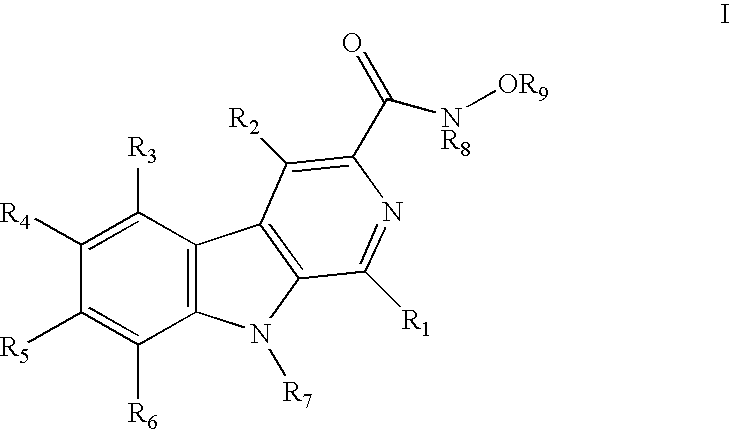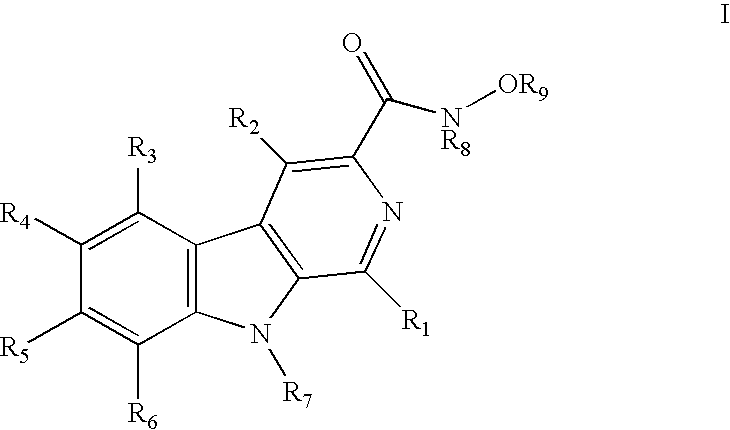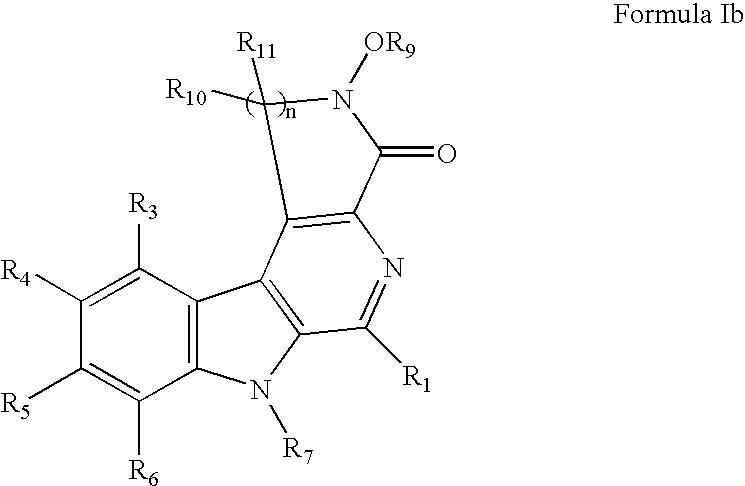HIV-integrase inhibitors, pharmaceutical compositions, and methods for their use
a technology of integrase inhibitors and compositions, applied in the field of betacarboline hydroxamic acid compounds, can solve the problems of limiting the ability of rt and protease inhibitors to safely and effectively treat and difficult treatment of aids and other hiv-caused diseases
- Summary
- Abstract
- Description
- Claims
- Application Information
AI Technical Summary
Benefits of technology
Problems solved by technology
Method used
Image
Examples
example 1
9-(4-Fluorobenzyl)-N-hydroxy-9H-β-carboline-3-carboxamide
[0228]
[0229]To a stirred solution of ethyl 9H-β-carboline-3-carboxylate (368 mg, 1.53 mmol) in DMF (4 mL) under a nitrogen atmosphere was added NaH (61.2 mg, 60% in mineral oil, 1.53 mmol) portionwise, followed by 4-fluorobenzyl bromide (0.19 mL, 1.53 mmol). Stirring was continued for 24 hours at ambient temperature, water (10 mL) was then added to the mixture. The precipitate was filtered, washed with water and dried to give a solid that was dissolved in methanol (20 mL). To the resulting solution, H2NOH (20 mL, 50 wt. % solution in H2O, 0.30 mol) was added. The suspension was stirred for 5 days at ambient temperature. The mixture was then filtered, and the solid was boiled in methanol (40 mL). After filtration, the title product (0.20 g, 39%) was obtained. 1H NMR (300 MHz, DMSO-d6): δ 11.28 (1H, s), 9.02–9.08 (2H, m), 8.85 (1H, s), 8.48 (1H, d, J=9.0 Hz), 7.10–7.84 (7H, m), 5.85 (2H, s). HRMS (M+H)+ found: 336.1157. Calcd fo...
example 2
9-[(5-Chlorothien-2-yl)methyl]-N-hydroxy-9H-β-carboline-3-carboxamide
[0230]
[0231]To a stirred solution of ethyl 9Hβ-carboline-3-carboxylate (300 mg, 1.25 mmol) in DMF (3 mL) under a nitrogen atmosphere was added NaH (50.0 mg, 60% in mineral oil, 1.25 mmol) portionwise, followed by 2-chloro-5-(chloromethyl)-thiophene (151 μL, 1.25 mmol). The stirring was continued for 21 hours at ambient temperature, water (50 mL) was then added to the mixture. The precipitate was filtered, washed with water and dried to give a solid that was dissolved in methanol (25 mL). To the resulting solution, H2NOH (25 mL, 50 wt. % solution in H2O, 0.38 mol) was added. The suspension was stirred for 4 days at ambient temperature. The mixture was then filtered, and the solid was boiled in methanol (25 mL). After filtration, the desired product (0.26 g, 58%) was obtained. 1H NMR (400 MHz, DMSO-d6): □ 11.28 (1H, s), 9.15 (1H, s), 9.01 (1H, s), 8.81 (1H, s), 8.44 (1H, d, J=8 Hz), 6.94–7.92 (5H, m), 5.99 (2H, s). H...
example 3
9-(3-Chloro-2-fluorobenzyl)-N-hydroxy-9H-β-carboline-3-carboxamide
[0232]
[0233]To a stirred solution of ethyl 9H-β-carboline-3-carboxylate (400 mg, 1.66 mmol) in DMF (5 mL) under nitrogen atmosphere was added NaH (66.4 mg, 60% in mineral oil, 1.66 mmol) portionwise, followed by 3-chloro-2-fluoro-benzyl bromide (371 mg, 1.66 mmol). Stirring was continued for 25 hours at ambient temperature, water (30 mL) was then added to the mixture. The precipitate was filtered, washed with water and dried to give a solid that was dissolved in methanol (25 mL). To the resulting solution, H2NOH (25 mL, 50 wt. % solution in H2O, 0.38 mol) was added. The suspension was stirred for 4 days at ambient temperature. The mixture was then filtered, and the solid was boiled in methanol (20 mL). After filtration, the title product (0.19 g, 31%) was obtained. 1H NMR (400 MHz, DMSO-d6): δ 11.33 (1H, s), 9.08 (1H, s), 9.04 (1H, s), 8.89 (1H, s), 8.51 (1H, d, J=8 Hz), 6.95–7.81 (6H, m), 6.00 (2H, s). HRMS (M+H)+ fo...
PUM
| Property | Measurement | Unit |
|---|---|---|
| molar ratio | aaaaa | aaaaa |
| temperature | aaaaa | aaaaa |
| wt % | aaaaa | aaaaa |
Abstract
Description
Claims
Application Information
 Login to View More
Login to View More - R&D
- Intellectual Property
- Life Sciences
- Materials
- Tech Scout
- Unparalleled Data Quality
- Higher Quality Content
- 60% Fewer Hallucinations
Browse by: Latest US Patents, China's latest patents, Technical Efficacy Thesaurus, Application Domain, Technology Topic, Popular Technical Reports.
© 2025 PatSnap. All rights reserved.Legal|Privacy policy|Modern Slavery Act Transparency Statement|Sitemap|About US| Contact US: help@patsnap.com



